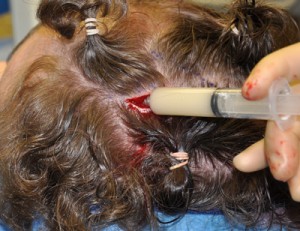The skull has a wide variability of external shapes and no two people have exactly the same looking head. But most of the time these skull shapes share one consistent feature…they are usually smooth. The outer bony surface has a relatively smooth convex surface which translates into a smooth feeling scalp on the outside. This is seen in most image of skulls of either actual people or mock skull models.
But the reality is that not every skull is completely smooth and many people can feel some degree of small lumps and bumps on their skull. This is well illustrated in the 19th century practice of the pseudoscience of Phrenology in which skull contour irregularities purportedly translated into a person’s psychological attributes. While Phrenology has long been discredited as having any relevance to a person’s psychological make-up, some of a skull’s dents and dimples are aesthetically bothersome to some people.
Why certain skull irregularities occur is not known in all cases. Some people have skull indentations from a history of neurosurgery or trauma but the vast majority of skull dents and dimples have no known identifiable cause. A very common reason that they exist is because of how the skull forms. The fusing of the skull plates after birth creates the possibility of indentations to occur at these fusion points, most commonly at the anterior and posterior fontanelles. The bone formed here may be thinner and form a very well defined ‘dimple’. But the skull fusion issue does not explain all skull dents or dimples as many lie beyond the fusion location of the skull plates.

I have tried every available cranioplasty material for this approach and find that PMMA has the easiest and most reliable handling characteristics. Because of its putty-like consistency and flow characteristics as it transitions into a solid polymer, it can be introduced through a small incision down to the bone. Depending upon the size of the dent or simple, 1 to 3ccs of material is usually all that is needed to fill it. While the amount of material to place is an artistic judgment, it is important to realize that it is better to underfill than overfill. You do not want to convert a skull dimple into a skull bump. The shape of the PMMA material introduced is then shaped by pressing from the outer scalp to smooth it down and around the defects as it cures and gets hard. The edges of the material are then checked with an instrument through the incision for smoothness.
Spot cranioplasty is the simplest type of skull reshaping procedure for small indentations or depressions of the skull’s surface. It can be done through an incision of minimal length. While a variety of cranioplasty materials can be used, PMMA offers the most reliable method of passing through a small incision and being able to be shaped by external scalp manipulation.
Dr. Barry Eppley
Indianapolis, Indiana


